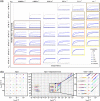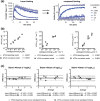Considerations for improved performance of competition association assays analysed with the Motulsky-Mahan's "kinetics of competitive binding" model
- PMID: 31444916
- PMCID: PMC7029771
- DOI: 10.1111/bph.14841
Considerations for improved performance of competition association assays analysed with the Motulsky-Mahan's "kinetics of competitive binding" model
Abstract
Background and purpose: Target engagement dynamics can influence drugs' pharmacological effects. Kinetic parameters for drug:target interactions are often quantified by evaluating competition association experiments-measuring simultaneous protein binding of labelled tracers and unlabelled test compounds over time-with Motulsky-Mahan's "kinetics of competitive binding" model. Despite recent technical improvements, the current assay formats impose practical limitations to this approach. This study aims at the characterisation, understanding and prevention of these experimental constraints, and associated analytical challenges.
Experimental approach: Monte Carlo simulations were used to run virtual kinetic and equilibrium tracer binding and competition experiments in both normal and perturbed assay conditions. Data were fitted to standard equations derived from the mass action law (including Motulsky-Mahan's) and to extended versions aiming to cope with frequently observed deviations of the canonical traces. Results were compared to assess the precision and accuracy of these models and identify experimental factors influencing their performance.
Key results: Key factors influencing the precision and accuracy of the Motulsky-Mahan model are the interplay between compound dissociation rates, measurement time and interval frequency, tracer concentration and binding kinetics and the relative abundance of equilibrium complexes in vehicle controls. Experimental results produced recommendations for better design of tracer characterisation experiments and new strategies to deal with systematic signal decay.
Conclusions and implications: Our data advances our comprehension of the Motulsky-Mahan kinetics of competitive binding models and provides experimental design recommendations, data analysis tools, and general guidelines for its practical application to in vitro pharmacology and drug screening.
© 2019 The Authors. British Journal of Pharmacology published by John Wiley & Sons Ltd on behalf of British Pharmacological Society.
Conflict of interest statement
S.S. is employed by Genedata AG, Switzerland.
Figures






References
-
- Bland, J. M. , & Altman, D. G. (1986). Statistical methods for assessing agreement between two methods of clinical measurement. Lancet, 1, 307–310. - PubMed
Publication types
MeSH terms
Substances
LinkOut - more resources
Full Text Sources
Medical

